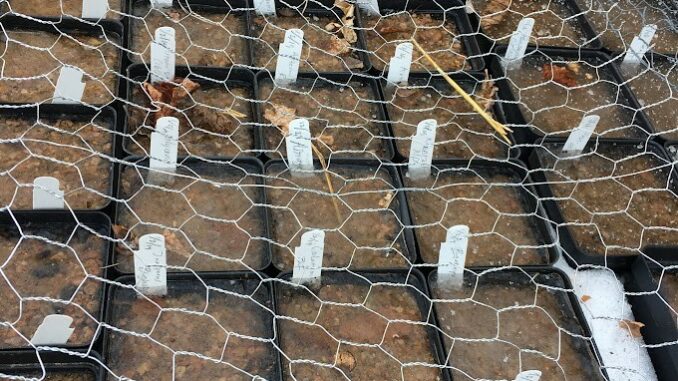
 by Bryan Fischer, Curator, and Horticulturist | Gardens on Spring Creek
by Bryan Fischer, Curator, and Horticulturist | Gardens on Spring Creek
A few weeks ago (published online on September 23 and in print slightly earlier), this column covered seed collection and cleaning. This article compliments that earlier piece and will discuss how to sow the seeds you’ve collected, cleaned, and stored.
By now, your seeds should be processed and packaged. If they aren’t, revisit “Saving Seeds” or continue with reckless abandon; your choice. Broadly, I handle my seeds in one of three ways that follow the natural course of the seasons: I sow them directly in the garden; I sow them indoors in spring; or, I stratify them (a cold and wet treatment that mimics winter). Almost all the seeds found in our gardens can be germinated with these methods and without special equipment. A quick internet search can reveal any needed treatments for plants that are new to you.
Seeds that do well when directly sown include annuals and most biennials. This method can work well for perennials but sowing in a more controlled environment generally results in better germination. Mimicking the cold and wet period that makes snow sowing effective, artificial stratification provides the best of both worlds.
The easiest way to stratify is to add seeds and an equal amount of vermiculite in plastic bags. Leave these in the fridge for the recommended stratification window (four months is usually plenty), and sow once either the window is complete or you see white roots emerging from the seeds. Stratification can also be accomplished outdoors by sowing one species per pot and setting the pots in a shady location that receives natural precipitation. Cover the pots with snow each time there is a storm and move pots into part sun when spring arrives. Seedlings can be potted up once they show two sets of true leaves. Species from dry regions like the Great Plains or desert SW are best pot-stratified in a media that is half sand; a straight potting mix is fine for others. Mulch seedling pots with a thin layer of pea gravel to keep them in contact with the soil, and don’t forget the labels!
Most garden seeds can be germinated as described above, as stratification is required for many garden plants and is generally harmless to those that don’t require it. That being said, a few types of seeds prefer other treatments: many seeds with thick coats, like pea-family members (family Fabaceae) and plants in the genus Sphaeralcea germinate most readily with scarification, a technique that makes their thick, hard seedcoats more able to imbibe water. In addition, many members of the sunflower family (Asteraceae) require light cues for germination. The latter is easily accommodated by surface sowing the seed and barely cover it with a single layer of vermiculite or gravel so that light reaches the soil surface.
To prepare seeds requiring scarification, soak them for 24 hours, and then rub them with an equal amount of sand between your fingers. Five or so seconds per pinch should do with moderate pressure. After scarification, seeds can be sown indoors or put into a stratification treatment, if necessary.
After a busy gardening season, cleaning seeds in fall and sowing seeds in winter make for relaxing, contemplative rituals by which many of us horticulturists mark the seasons. By gathering supplies now, you can be ready to sow the first week of the year.
Support Northern Colorado Journalism
Show your support for North Forty News by helping us produce more content. It's a kind and simple gesture that will help us continue to bring more content to you.
BONUS - Donors get a link in their receipt to sign up for our once-per-week instant text messaging alert. Get your e-copy of North Forty News the moment it is released!
Click to Donate